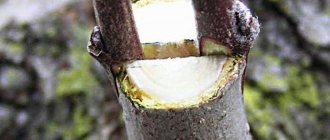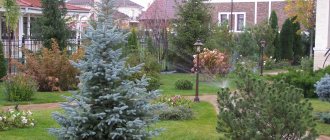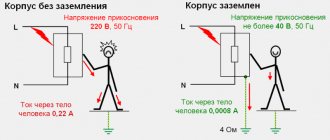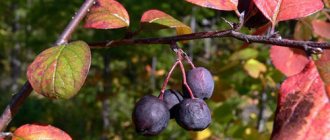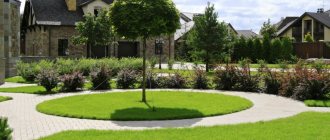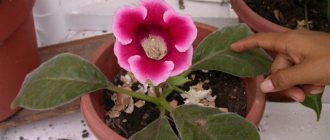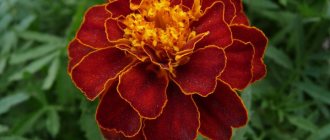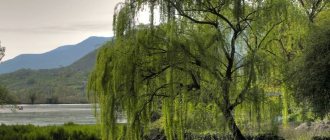An apple tree is a fruit tree that can live for more than 3 decades (some varieties live for more than 60 years). Over time, this plant ages: this is indicated by factors such as drying out of the crown, exposure of branches, and a decrease in yield. Old apple trees bear fruit mainly in the peripheral part of the crown, their fruit quality decreases, and often they do not reach the size required for the apple tree variety. In this material we will tell you how to properly rejuvenate an old apple tree, what pruning can be done in the spring, how to do extreme pruning of an apple tree and how to properly care for the tree after the rejuvenation procedure.
Basics of pruning old apple trees
Old apple trees are pruned in late February or early March. It is used only for trees that have not yet entered the growing season. In this case, the following rules for working with branches are taken into account:
- In tall apple trees (Fuji, Streifling), the shoots are shortened so that the height of the tree is reduced by a third.
- All cuts are made at an angle of 45 degrees - this promotes better overgrowth.
- The skeletal branches are not touched during rejuvenation, as this can greatly weaken the tree.
- Large branches with a diameter of 10 cm or more are removed no more than 2 at a time. Violating this rule can greatly weaken the tree.
- Small branches with a diameter of up to 4 centimeters are cut directly above the bud.
- During rejuvenation, all knots and stumps are removed. Large wounds left behind are filled with cement mortar. Otherwise, hollows may form in their place.
- The branches are cut so that the tree grows vertically. As part of rejuvenation, all shoots growing downwards, crossing branches and shoots growing close to each other are removed. Also, cut off branches that are close to the roots as much as possible.
- After pruning, watch for new shoots. Only those that grow well, have no visible defects and are located at a distance of at least 50 cm from each other are left. All others are removed as soon as their length reaches 10 cm. This can be done at any time of the year.
All sections with a diameter of more than 5 centimeters must be covered with a dark film. It can only be removed in September.
Schemes for pruning apple trees in spring
When pruning apple trees in the spring, the pattern of cutting branches on adult and young trees is different, but there are also similarities.
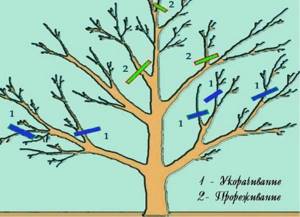
The choice of pattern for pruning the crown in spring depends on the goals and age of the apple tree.
Why pruning apple trees in spring:
- apple tree health;
- it is required to make it convenient to pick apples;
- for the growth of strong young shoots in the required direction;
- for good oxygen penetration and illumination of the tree;
- cutting dry and damaged branches.
A tree that has a dense crown produces small apples, their number is significantly less than that of a well-groomed tree. It is especially important how to prune an apple tree in the spring for beginners.
The crown shape can be different:
- medium-standard;
- fusiform;
- combined;
- sparsely tiered.
Important! It is easiest to form a sparsely tiered crown. To do this, you need to leave 5 skeletal branches at a distance of 35-40 cm from one another, and cut off the excess ones.
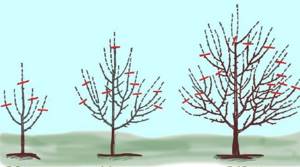
It is also easy to form a medium-standard crown if you cut off all the branches located at a height of 0.8-1.1 m from the ground surface. All remaining branches develop on their own.
Required tools and materials when properly pruning apple trees in spring:
- garden hacksaw;
- lopper; saw;
- garden var;
- pruner
What pruning is done in spring?
In the spring, rejuvenating tree pruning is carried out. They start in March in dry, sunny weather. Rejuvenation must be carried out before the tree is filled with sap, otherwise it may die during the pruning process. To rejuvenate a tree, branches are cut obliquely above the bud from top to bottom so that the top is flush with the bud. When properly pruning an apple tree, the central branches of the crown should be shorter than the side ones. Otherwise, it will be possible to say that the pruning was carried out incorrectly. Read about planting apple trees in spring here.
If a gardener has to deal with a frostbitten apple tree, it is recommended to postpone pruning it for a month. This will make it easy to determine how badly the plant is damaged and make pruning more effective.
Pruning apple trees in spring: timing
Trees begin to be pruned at a time when there is no intense sap flow.
The deadline for pruning apple trees in the spring in the Moscow region and central regions of Russia is the end of March, but if there is still snow on the site, then wait until it melts. It is better that the air temperature is above zero.
In April, shoots are cut off from trees in the north. It is necessary to prune before the buds begin to swell. Pruning a young tree with budding buds greatly reduces the number of fruits.
Important! Young apple trees are pruned in spring and autumn, and old apple trees in the spring so that the wounds have time to heal.
Step-by-step rejuvenation
The apple tree pattern always starts from the southern part of the tree. The treated part of the crown after completion of the manipulations should have a height of no more than 3 meters, and a length of no more than two. It is recommended to remove all semi-skeletal branches: they are shortened as much as possible, but skeletal branches are not touched unless absolutely necessary. Fruiting occurs on the northern part of the plant. 4 years after pruning the southern branches, you can move on to rejuvenating the northern part, where semi-skeletal branches also need to be pruned. Find out about planting and caring for the Talgar beauty pear here.
If you trim both parts of the apple tree at the same time, it will significantly reduce its yield, and if rejuvenation is carried out incorrectly, it may even die. In the best case, the tree will restore its productivity in two years.
Extreme pruning

- Initially, they examine the condition of the tree, checking it for hollows, damage, and signs of disease.
- After this, the crown is cut 2 meters from the leaf shoot. It is not completely exposed during such pruning.
- The tree sections are treated with garden varnish and also covered with a dark film.
Such pruning is carried out only in the spring, observing all the rules on agricultural technology. If you do it in the fall, the shoots may freeze in winter.
Maximum crop
As a rule, maximum pruning is carried out in the spring. But this can be done before winter. The procedure is carried out on a sunny and dry day. First, they begin to thin out the crown. To do this, choose a place where there are the most branches. Remove the largest and longest branches. It is not recommended to leave stumps to avoid rotting and disease of the plant. The cut areas are treated with paint or garden varnish.
Maximum pruning is carried out only when some natural disasters have occurred. For example, hurricane, hail, freezing rain, severe drought or very cold winter.
On a note!
With maximum removal, remove all dry, damaged branches. Trim completely to healthy wood.
Only natural disasters cause this type of procedure. Otherwise, you can cause great harm to the tree. Experienced gardeners do not recommend maximum pruning for beginners, since, unknowingly, they can remove good shoots, thereby harming the plant. The methodology takes into account the three-tier principle. According to him, apple trees have long branches.
Root rejuvenation
This type of rejuvenation is carried out only 4 years after the rejuvenation of the southern part of the crown. In this case they act like this:
- On the south side of the trunk, you need to dig a trench up to 75 cm deep and a length that matches the length of the crown.
- Exposed roots need to be separated. The fibrous ones should be bent, and the thick skeletal ones should be cut with an ax or shovel. The remaining roots must be removed and the cuts treated with garden varnish.
- After pruning, the fibrous roots need to be placed back in the trench.
- The trench itself must be filled with a mixture of fertile soil and humus, mixed in equal proportions with the addition of wood ash and mineral fertilizer. In cases where the gardener is working with sandy soils, clay and peat will definitely need to be added to this mixture.
It is recommended to prune the roots in the fall (from mid-October) before spring pruning of the northern part of the crown. This will allow the tree to recover better.
Care after pruning
After cutting the branch, the exposed wood is treated with one of the following compounds:
- garden var;
- oil paint without solvent. Solvent-based paints are harmful to wood. It is recommended to add a fungicide to the paint, for example, copper sulfate;
- a mixture of 10 parts lime and 1 part copper sulfate;
- a mixture of mullein and clay, taken in a 1:1 ratio.
Gardeners often use Zhukovsky's var. Preparation procedure:
- rosin, melted beef fat (warmed up) and yellowish wax are mixed in equal proportions until smooth;
- When cooled, the mixture is poured into cold water;
- after some time, when the composition has curdled, it is removed and molded into a lump.
For storage, the product is wrapped in several layers of oil-soaked paper.
Var is used only in the warm season (it hardens in the cold). After application, the cut area is covered with a cloth, because the composition attracts insects. It is useful to inspect the tree after pruning for the presence of moss or lichen.
Having grown, their colonies harm the tree, so it is advisable to remove them in a timely manner. The moss is scraped off with a piece of plastic, then the area is treated with copper sulfate and garden pitch.
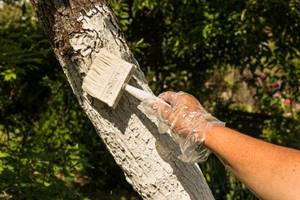
Lichens are removed using a homemade product:
- mix slaked lime and clay in a 1:1 ratio;
- dilute the mixture with water to a creamy consistency;
- apply the product to the lichen, and when it dries, scrape it off with a piece of plastic;
- After the bark has dried, coat the area with garden varnish.
The procedure is completed by treating the trunk with a 3% solution of ferrous sulfate.
Caring for an old apple tree
After pruning, especially extreme pruning, the plant needs to be cared for. It is imperative to apply fertilizer to the tree trunk circle. These should be:
- up to 20 grams of urea;
- up to 19 grams of superphosphate;
- up to 19 grams of potassium chloride;
- up to 8 kilograms of organic fertilizers;
- Great Dane 250 grams of wood ash.
The indicated portions of fertilizers are applied per square meter. To add fertilizers to the soil, it is loosened with a pitchfork or dug with a shovel to a depth of 15 cm, no more.
To restore an old tree, a different method of fertilizing is used: through wells or grooves. If the gardener decides to use wells, at least 20 of them are dug in the tree trunk circle of the crown. The depth of such wells must be at least 60 centimeters; fertilizers are added to them in dissolved form . The grooves are dug outside the tree trunk circle; they are made 50 centimeters wide and 40 centimeters long. After applying fertilizer, the grooves are buried. This link will tell you about the characteristics and description of the Shalunya cherry variety.
After pruning, trees also benefit from foliar feeding. It is recommended to carry it out in mid-summer. They use a 1% urea solution, prepared in a ratio of 100 grams of fertilizer per 10 liters of water.
Tips for beginners
To carry out pruning correctly, a young gardener needs to take into account several rules for carrying out such work. They provide:
- Using only well-sharpened, serviceable tools that are free of rust for wood processing.
- Mandatory disinfection of used equipment before work. It is better to use medical alcohol or a special antiseptic for such purposes. It is necessary to re-process the instrument after each cut so as not to introduce an infection into the wound of the apple tree.
- All cuts must be treated with garden varnish. This must be done before the meta sections are dry.
- It is necessary to use such rejuvenation schemes, after which the central part of the crown will be well illuminated.
Read about growing and caring for Ferruginous cherries in this article.
Under no circumstances should the recommendations for pruning times be violated. This can lead to the death of the apple tree.
When pruning a tree, special attention should be paid to the selection of branches. To maintain the productivity of the apple tree, you need to leave the following branches:
- ringlets - processes up to 5 cm long, which have ring scars on the bark and an apical bud;
- spears - shoots up to 15 cm long, which are located in relation to the branch at an angle of 90 degrees, have a large number of buds and thorns on the bark;
- fruitful twigs - are straight or curved long branches.
This material will tell you about the cultivation and description of the onion variety Exhibition.
Such branches can and should be left if they have no major damage or signs of disease. Weak, frostbitten shoots will need to be removed - they will not be able to bear fruit even after spring pruning.
Methods and techniques
Depending on the goals pursued and the age of the apple tree, there are various pruning methods and patterns.
Methods
Initially, decide how much crown needs to be removed. The cutting method will depend on this.
- Pinching
Firstly, this is the name given to pruning apple tree seedlings after planting during the first year of their life. You can’t take off a lot so as not to disrupt growth and development. Secondly, in the future this method is also used, but to remove the apical part of annual green growths. The most gentle of all procedures.
- Weak pruning
It is usually carried out on young apple trees. Branches (most often skeletal, to form a crown) are cut off by no more than ¼.
- Average
It is carried out on fairly mature trees that are more than 5 years old. The crown is renewed more intensively by ⅓ of the total volume.
- Strong
It is needed primarily to renew an old apple tree. However, it may also be forced if most of the tree is infected with fungus or damaged by pests. In both cases, almost half of all branches are removed.
Techniques
Depending on what part of the branch needs to be removed, the pruning technique is selected.
On the ring
It is used if a branch is completely removed, most often when it is necessary to rejuvenate the tree.
Scheme:
- Find a ring-shaped growth at the growth point (this is the very base of the branch).
- Step back literally 0.3-0.5 cm from it, make a mark with a marker.
- Treat both the tool and the branch with a disinfectant antifungal agent. You can take a solution of copper (3%) or iron (5%) sulfate.
- Using a garden hacksaw, carefully cut off the branch along the mark you made.
- Treat the wound with garden varnish (linseed oil or oil paint).
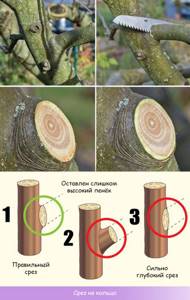
If you saw off right down to the base without leaving a protrusion, it could damage the cambium. Because of this, sap flow will be disrupted and the condition of the apple tree will worsen. If the distance is made too large, a stump will form, which will dry out over time, fall off along with a ring-shaped growth and form a hollow in the trunk, which will definitely not benefit the tree.
If everything is done correctly, the cut will heal in a short time, because in the ring-shaped growth cell division proceeds very quickly - regeneration is enhanced. Therefore, this technique is considered one of the less traumatic.
On the kidney
Used if you need to remove only part of the branch. Most often this is formative or regulatory pruning to expand the crown or reduce its density.
Scheme:
- Determine the bud that will be left on the tree.
- Measure 5 cm from it, make a mark with a marker.
- Cut off at the marked location. If the branch is thick, it is carefully sawed off with a garden hacksaw. If it is thin (less than 5 cm), it is better to use a ratchet pruner, lopper or hedge trimmer.
- Treat the wound with garden varnish (linseed oil or oil paint).
The 5 cm distance must be strictly observed. If it is larger, a stump will form (as when cutting into a ring). If it is less, there is a risk of disrupting the processes that nourish the kidney. In this case, not only she, but the entire branch may die.
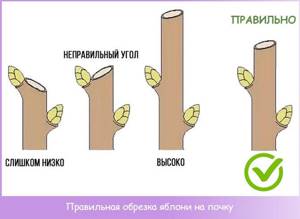
The buds on the branch are located alternately: one - towards the center, the next - outwards. Therefore, in gardening there are such concepts as pruning the outer bud (the one that is directed to the outside world is left) and the inner one (the one towards the trunk). The first is done if necessary:
- make the middle rarer;
- increase the amount of sunlight penetrating the trunk;
- expand the crown diameter.
Pruning to the inner bud is recommended if required:
- raise the lower branches that are too drooping;
- thicken the tree from the inside;
- strengthen skeletal branches.
Cuts on a kidney heal much slower than cuts on a ring.
conclusions
- Apple trees are considered old if they have bare knots, a dried out crown, and also support fruiting only on the peripheral part of the crown.
- Apple tree pruning for the purpose of rejuvenation is carried out in the spring. As part of such pruning, all semi-skeletal branches are shortened, diseased shoots and twigs are removed. Crown pruning is carried out in stages - work always starts from its southern part, and after 4 years they move to the northern part.
- Along with pruning the crown, roots are rejuvenated. This is done 4 years after the southern part of the tree is rejuvenated. The skeletal roots are removed, after which I fertilize the soil in the tree trunk circle.
- For severely neglected apple trees, extreme pruning is done. With this treatment, the tree crown is shortened by 2 meters.
- After spring pruning, the tree must be treated with garden varnish, and the largest sections are covered with a dark film. Fertilizer is added to the roots of the apple tree to promote rapid recovery of the plant.
Sanitary pruning
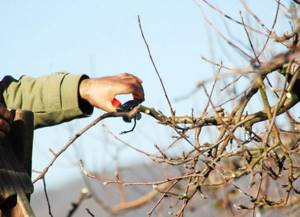
This type of pruning allows you to remove unnecessary and damaged twigs and branches. It is carried out when trees are exposed to disease or after natural disasters. The essence of sanitary pruning is to remove infected, dead branches. In an old apple tree, these shoots and branches are removed up to the fruit ring. When filing, only parts of the branch include a small healthy area. Thus, recurrence of damage and infection is prevented. If broken branches are found on the tree, they are removed using pruning shears. Only the broken part is cut off.
Sanitary pruning is also done in the spring. In this case, frozen branches that could not withstand severe frosts in winter are cut off. The procedure is carried out after spring frosts, when their return is already minimal. All cut branches are burned.

